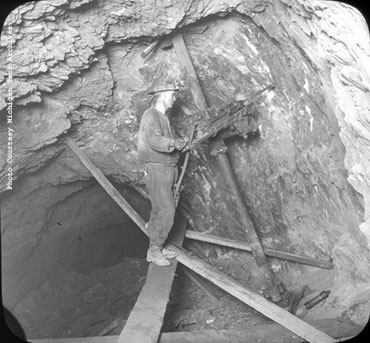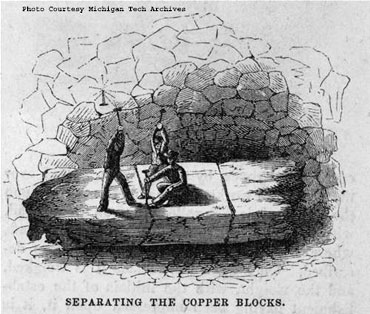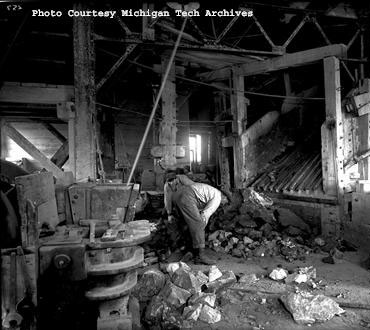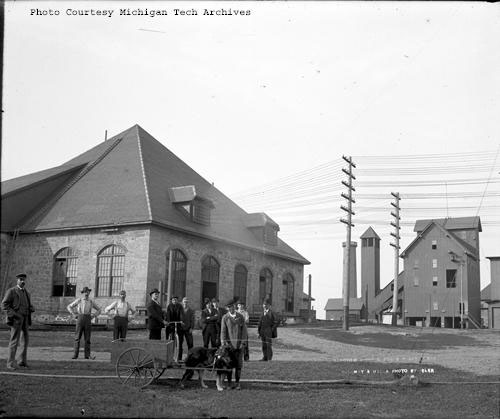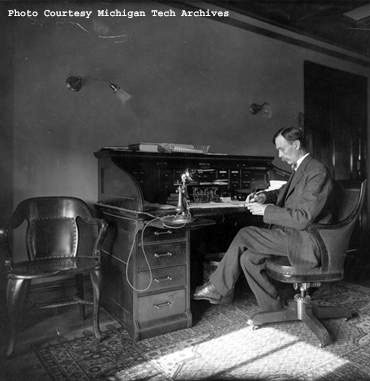|
Underground
Mining captain, assistant captains and shift
bosses
Historically, the use of the word captain comes
from a Cornish tradition in which the “man
in charge of mining work” was termed a
captain. The mining captain is the executive
officer underground. Mining captains, assistant
captains and shift bosses managed the underground
work force, assigning employees to different
jobs underground and taking direct oversight
of all work. In the early years of Michigan’s
copper mines, mining captains were almost always
Cornish immigrants who brought decades of underground
experience with them (in later years, the work
of the experience-bred mining captain gave way
to the college-educated mining engineer). mining
captains are often identified in photos by their
white clothing.
Underground work was overseen by a hierarchical
structure of managers. A single mining captain
might manage an entire mine operation, with assistant
captains in charge of individual shaft or underground
working area. Shift bosses were responsible for
individual groups of men and might be more directly
involved with actual underground work.
Miners and blockholers
Not everyone who worked underground could use
the title miner. In most mining settings, miner
referred to the very few employees who actually
operated a drill or drilling machine, filled
holes with explosives and set off charges. The
position of miner was considered a skilled job
and was usually paid at a higher rate than other
employees. In early years, drilling was done
by hand (with hammers and hand steels) and black
powder was inserted in the finished holes. Later
years saw the introduction of machine drills,
nitroglycerine and dynamite. Some immigrants
to Michigan’s copper district brought mining
skills from districts in their home countries.
Throughout the Keweenaw’s history, Cornish
immigrants held a large number of jobs as miners.
But Irish and German immigrants also emerged
in these skilled roles and, in later years, underground
workers of other ethnicities rose through the
ranks to the position of miner.
In come cases an initial explosion created pieces
of rock that were too large to move. Men known
as blockholers would drill and blast these rocks
into smaller pieces. Blockholers were also given
the dangerous job of drilling and blasting rock
which had become jammed in chutes or special
tunnels for passing rock from one level to another.
The work of the blockholer, though requiring
the skillset of a miner, was considered more
dangerous particularly when clearing rock chutes.
Contract miners, contract teams, and drill boys
Many miners worked on a contract – and
were known as “contract miners” – and
agreed to sink shafts, “drift” (excavate
underground tunnels) or “stope” (remove
copper rock within the mine). Rather than being
paid a regular hourly or monthly salary, these
contract miners were paid negotiated price for
each foot or cubic fathom removed; the more work
they did, the more work they could receive. Contract
miners usually worked in teams of 4-6 men, with
contracts negotiated and paid on a monthly basis.
The contract system was imported by Cornish miners,
but contract teams in Michigan mines included
teams from many different ethnic groups. Teams
often included several members of an extended
family.
Most contract teams included a drill boy, whose
job was to retrieve supplies (including replaceable
drill steels) from the shaft and deliver them
to the men working the drills. Drill boys earned
about half the money that a skilled miner might
earn. Very often, a drill boy was the son of
a member of the contract team and eventually
moved up to fill a regular position alongside
his father or uncles.
Cutters and chiselmen
Geologically, Michigan’s copper mining
district differed from other mining because the
ores in the Keweenaw featured copper in its native
metallic form. Rather than forming in sulfide
or oxide compounds which required different types
of chemical separation and smelting technologies,
Michigan’s “native copper” deposits
were invested with pieces of actual copper metal.
In most lodes, these pieces of copper were just
tiny flecks of metal disseminated through the
surrounding rock, sometimes composing less than
3% of the total. In other places, large masses
of pure copper formed, some weighing hundreds
and thousands of pounds. Although profit could
be made from these masses of copper, a different
type of workman was needed to remove them from
the underground mines.
The copper was too soft to blast with explosives,
so the masses had to be separated into smaller
pieces which could be removed from the mine.
In the early years, chiselmen would be employed;
using a flat-edged chisel and hammer, these men
would cut a long groove along the face of the
copper (often producing beautiful “copper
fans” as they chiseled off long bands of
metallic copper). Once the groove was deep enough,
pry bars or small explosive charges could be
used to break the smaller chunks away. In later
years, cutters were employed to work masses of
copper. Using pneumatic chisel hammers, these
men would cut through the mass of copper. In
other mines, holes were drilled right through
the copper masses using a pneumatic twist drill.
Forming a line of holes along an edge, explosives
could be used to dislodge smaller pieces, breaking
the copper along the perforation similar to a
postage stamp.
Trammers, muckers and track men
Once the rock was blasted away, men would load
the broken ore into tram cars to be moved to
the nearest shaft. In some mines, muckers did
the work of shoveling the rock into tram cars,
while trammers pushed them along rails to the
shaft; in many mines, however, these two jobs
were both done by the trammer. In later years,
trammers also operated electric and battery-powered
underground locomotives. Track men installed
and maintained the small-guage rail tracks that
the tram cars moved along.
Mucking and tramming were the most difficult
and back-breaking jobs underground. As it required
little skill to shovel rock and push heavy tram
cars, these positions were often given to unskilled
immigrants with little mining experiences. Early
waves of Finnish immigrants often found themselves
in this sort of work, and trammers were later
drawn from the unskilled immigrants from Croatia,
Slovenia and Italy.
Pickers, fillers, wallers
In some mines, particularly the low-grade ore
bodies of the Copper Range Company mines, rock
was sorted underground so that only the most
valuable pieces were hoisted to the surface.
In these settings, pickers did the work of selecting
the higher-value ore, while fillers moved waste
rock to underground storage areas (often “filling” disused
stopes with waste rock to help to prevent cave-ins).
In some mines, wallers were used to stack waste
rock into walls along underground tunnels.
Timbermen and sprinklers
Wood was used to construct shafts and to provide
support underground. Timbermen were employed
to move, cut, install and maintain wooden structures
underground. These would include shaft timbers, “stulls” (support
timbers, often the relatively untouched trunks
of large trees) and square set timbering in which
individual pieces of cut timber were formed into
cube-like support structures. Although some historians
feel it may be an ethnic stereotype, recent research
confirms that French-Canadians comprised a high
percentage of the timbermen in Michigan mining
companies. Because of the danger of fire from
dry timbers, sprinklers were employed to spray
water and other fire-retardant chemicals onto
wooden structures underground.
Surface
Surface superintendent, surface captain and
surface bosses
Like the underground portion of a mine, the
surface portions of the mine included a variety
of activities and employees. Management of these
functions was usually given to a single surface
superintendent, with lower levels of responsibility
assigned to surface captains and surface bosses.
In the early years of Michigan’s copper
district, superintendents were often American
managers sent in to oversee the mine operations.
It wasn’t long, however, before experienced
non-American underground miners and mine captains
ascended to fill these roles.
Rock house laborers, kiln men and car fillers
At the surface of the shaft, rock was dumped
from ore cars and processed by rock house laborers – either
in a separate rock house, or in a combination
shaft-rockhouse. Ore was sorted by size (and
sometimes by grade), put through different crushing
machinery and sent to different storage bins.
As with the underground work of mucking and tramming,
rock house work was often considered unskilled
and ethnic immigrants from Finland, Italy, Croatia
and Slovenia were often employed in this back-breaking
work.
In the early period of Michigan copper mining,
many mines used kilns to heat piles of copper
ore. Kiln men poured water onto the heated stone,
causing the rock to shatter into small pieces
that could be shipped to the stamp mill. Once
rock was sorted, car fillers would load it into
railroad or tram cars for shipment to the stamp
mill.
Hoisting engineers, hoist tenders and wipers,
landers and roll men
Hoists were used to raise ore from a mine and
lowering men and supplies to the various working
levels. Hoisting drums allowed lengths of cable
to be unwound into the mine, with interchangeable
vehicles attached to their cables: a “mancar” or “cage” would
carry men, while rock skips and baling skips
were used to lift ore and water (in the region’s
early history, an iron bucket or “kibble” was
also used to hoist rock and supplies). At the
surface, a variety of personnel were required
to operate and maintain these large pieces of
machinery. Hoisting engineers were very important
employees who had direct control of the hoisting
engine and, therefore, were responsible for the
lives of the men descending into the mine. Hoist
tenders and wipers worked around hoisting engines,
monitoring operations, checking for the wear
of parts (such as braking mechanisms) and cleaning
and filling various hydraulic fluids.
A lander was stationed at the mouth of the shaft
and would assist men stepping from the mancar
or assist laborers in removing supplies or loading
rock skips (in some mines, landers also worked
at each operating level underground). Roll men
maintained wooden rollers within the mine shaft
which carried the weight of the hoisting cable
and helped to reduce the wear of this important
commodity. Smaller underground hoists were also
used to move materials between levels within
in the mine.
Pump and compressor engineers, tenders and pipe
men
Compressors produced compressed air used underground
in the operation of mechanized rock drills and
other types of machinery. Use of this machinery
also helped to circulate foul air away from the
working areas of the mine. Rock drills also used
water to keep down small particles of rock and
dirt which caused breathing and lung problems
for underground workers. Operation and maintenance
of this equipment required a number of engineers,
tenders and pipe tenders
Firemen & boiler tenders
Teaming and Railroad
Supplies, equipment, men and rock were moved
about the surface in a variety of ways. Some
companies utlized teams of horses with different
types of carts and vehicles; the use of horses
(or teams of horses) was referred to as teaming
and men employed in this work were sometimes
referred to as teamsters.
The larger and more developed mines constructed
small rail lines – or tramways – over
which material could be moved in small wheeled
cars. The largest of these companies also created
fully-operational railroads. Some were private
lines, working over privately-owned rail lines
such as the Quincy and Torch Lake Railroad of
the Quincy Mining Company and the Hecla and Torch
Lake Railroad, operated by the Calumet & Hecla
Copper Company. The Copper Range Company built
the Copper Range Railroad, which served both
as a private railroad for its mining operations
and as a “common carrier” for smaller
mining companies. The Copper Range also offered
a passenger and freight service to the general
public.
Like stamp mill operations and smelting works,
the fully-functional railroads employed men in
a variety of positions that are too numerous
to detail here.
Other skilled surface workers
The surface workings of an active mining company
included a large number of ancilliary operations.
Historically, metal parts for machinery were
not mass-produced so a company’s foundry,
blacksmith shop and machine shop might employ
foundrymen, smiths and machinists to use forges,
anvils and machine tools to fabricate wheels,
stamp shoes, rock skips, girders and other metal
pieces.
Carpenters often worked in a mine’s dedicated
carpenter shop to fabricate wooden items such
as support timbers, shaft linings, and brake
shoes for hoists.
Masons worked with stone, building foundations
for buildings, support structures for railway
lines and sometimes walls along underground tunnels.
Michigan copper mines were some of the first
sites in the Upper Peninsula to install electricral
systems. Electricians had the job of installing
and maintaing electrical systems, including lighting
and telephone lines, as well as high-voltage
power to industrial equipment.
A master mechanic was often employed to oversee
much of this surface work. For instance, when
a new hoist was installed, the master mechanic
might direct masons in constructing a foundation
and assist carpenters and machinists in fabricating
the machinery to be installed in the structure.
Diamond drill
A specialized type of drilling equipment called
a diamond drill was used to take samples of rock.
Using a special hollow drill (with the tip coated
in black diamonds), a diamond drill would bore
a hole through the ground and remove a long tube
of rock (usually called a core sample) that could
be examined and tested for its metallic content.
Diamond drills were sometimes used underground
to explore the rock beyond the end of a tunnel,
but were also used at the surface to test land
purchases for possible new mineral deposits.
Change house or “Dry House”
Underground workers had a locker room facility
available to them near the shaft house. At the
beginning of their shift, they could change out
of their street clothes into working clothes
before going underground. At the end of their
shift, they could remove their clothing – which
was usually wet from their underground work – and
shower before dressing in their “dry” street
clothes. Wet working clothes were left in the
heated building (sometimes hung from chains near
the ceiling) to dry overnight. As a result, this
building was usually referred to as a “change
house” or “dry house.” Men
employed to work in these buildings were known
as change house men or simply dry men.
Watchman and firemen
Security was an issue at most mine locations,
though the larger concern was usually against
catastrohpic fires rather than left or sabotage.
Companies which turned to outside insurance companies
for fire insurance usually paid lower premiums
if they employed watchmen who made regular rounds
of buildings checking for signs of fire. Larger
companies, such as the Calumet & Hecla were
self-insured, but still employed large security
forces to monitor their properties. Although
most companies relied on community fire departments,
some locations (particularly those which were
remote from towns and cities) employed their
own private firemen to fight fires that might
arise at their industrial sites.
Surface laborers
Many of the specialized jobs listed in this section
required specific skills and experience. Most
of the work on the surface of a mining operation,
however, was carried out by surface laborers
who would paid a daily wage and assigned to ever-changing
(and often back-breaking) tasks. Surface laborers
might one day dig a ditch alongside a road or
move several cords of firewood to a boilerhouse;
the next day they might lay a stone coarse for
a building foundation or move tons of waste rock
to underfill a railway trestle.
Office / Administrative
Mine superintendent / general manager
The mine superintendent or general manager was
in charge of all of the company’s operations,
both above and below ground. All of the functional
operation managers reported to him – the
mining captain, surface captain, master mechanic,
chief mining engineer and chief clerk. The mine
superintendent was the only direct link between
the Michigan-based mining operation and the company’s
corporate headquaters, which were often located
in an East Coast city such as Boston, New York
or Philadelphia.
Mine superintendents were very powerful and
influtential men in the Copper Country. Individuals
such as Charles Lawton, superintendent of the
Quincy Mining Company, and James MacNaughton,
general manager of the Calumet & Hecla Copper
Company, were directly responsible for the lives
of thousands of workers, the production of millions
of pounds of copper and the profits of corporate
shareholders.
Chief Clerk, supply clerk and assistants
In modern usage, the word clerk usually refers
to a menial or unskilled position. Historically,
however, clerks were the accounting and financial
experts within any corporation. The chief clerk
at a mine was comparable to what we might see
as a chief financial officer or controller in
today’s corporate setting. The chief clerk
would employ
Mining engineer, geologist, assayer and assistants
Horace Stevens applied the title mining engineer
to “any man having sufficient ability to
pass intelligently upon mineral values and to
open and operate a mine, whether such ability
were gained in a school or by practical experience.” After
1900, mining engineers were usually college-trained
men who worked above ground in charge of all
decisions about the mine’s underground
workings. Graduates of mining schools, such as
the Michigan Mining School in Houghton, often
sign the letters M.E. after their name to indicate
that they had received a college “Engineer
of Mines” degree. An assayer conducted
chemical tests on samples taken underground (or
from diamond drill tests) to determine the exact
content and value of any metal or metals in a
specific part of the mine. These determinations
assist the geologist in understanding the geology
of the underground workings and help to determine
future development of the mine workings.
Chief engineer, engineers, architects, draftsmen
Because of the remote location of Michigan’s
copper district, much of the design and construction
work for buildings, equipment and tools had to
be done onsite. Many mining companies employed
engineers, architects and/or draftsmen to draw
and communicate needs to company machinists and
carpenters. The Calumet & Hecla Copper Company
even had its draftsmen design storage cases for
their own blueprint collections – storage
cabinets which were built by the company’s
carpenters and housed in a headquaters building
designed by company architects and built by company-employed
stone masons.
Time keeper, stenographer & clerical
assistants
Time keepers were the human predecessor of the
modern time clock; instead of punching a card
with a time clock, mine employees would stop
at timekeeper’s office on their way to
and from work. Records were kept for the amount
of time each man worked – in some cases
hours, in other cases days or even weeks. At
the end of the month, information from “time
books” was tallied to produce paychecks.
Mining company offices usually employed a number
of stenographers and clerical assistants to help
create, collect and organize the records of the
company. Mines were in constant communication
with their East Coast executive offices, as well
as suppliers, machinery manufacturers and local
merchants. Larger mines might also maintain correspondence
between different functional units within their
Michigan locations (mine, railroad, stamp mill,
and smelter). The financial activity of the company
was recorded in elaborate sets of ledgers, financial
journals, account books and files. Toward the
end of the Nineteenth Century, new concepts of
cost analysis and efficiency encouraged companies
to develop detailed accounts of all aspects of
the mine’s activity which could allow calculation
of costs associated with every man-hour of work
done in the mine and for every pound of copper
the company produced.
It is useful to note on this last section that
stenography and clerical work were some of the
only positions filled by women at Michigan copper
mining companies. |


